Dell PP01X User Manual
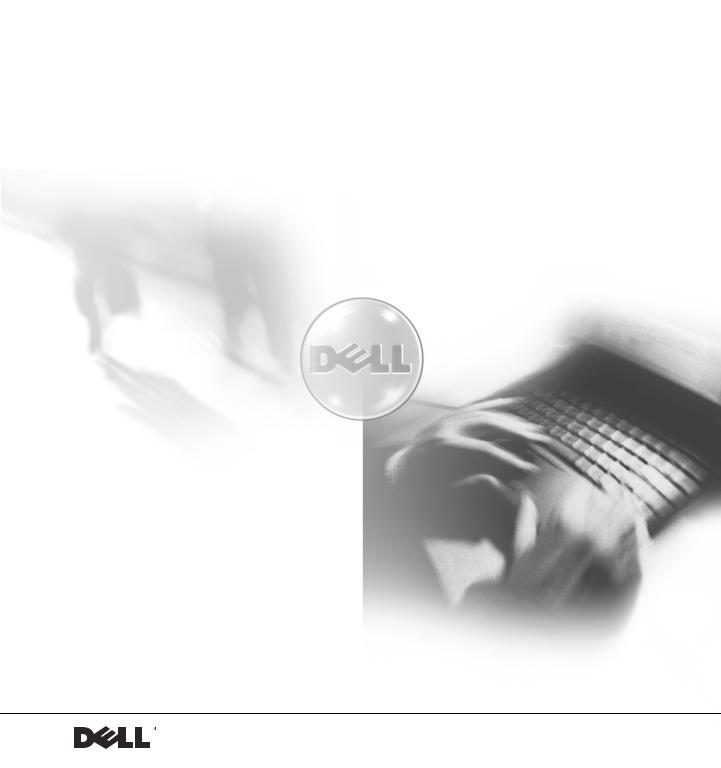
Dell Precision™ Mobile Workstation M50
System Information Guide
Příručka k zařízení
Systeminformation
Järjestelmätiedot
Rendszerinformációs kézikönyv
Veiledning for systeminformasjon
Przewodnik – informacje o systemie
Руководство по системе
Príručka so systémovými informáciami
Priročnik z informacijami o sistemu
Systeminformationsguide
תכרעמל עדימ ךירדמ
Model PP01X
w w w . d e l l . c o m | s u p p o r t . d e l l . c o m

Dell Precision™ Mobile Workstation M50
System Information Guide
w w w . d e l l . c o m | s u p p o r t . d e l l . c o m

Notes, Notices, and Cautions
NOTE: A NOTE indicates important information that helps you make better use of your computer.
NOTICE: A NOTICE indicates either potential damage to hardware or loss of data and tells you how to avoid the problem.
 CAUTION: A CAUTION indicates a potential for property damage, personal injury, or death.
CAUTION: A CAUTION indicates a potential for property damage, personal injury, or death.
Abbreviations and Acronyms
For a complete list of abbreviations and acronyms, see the User’s Guide (depending on your operating system, double-click the User’s Guide icon on your desktop or click the Start button, click Help and Support, click User and system guides, and click User Guide).
____________________
Information in this document is subject to change without notice. © 2002 Dell Computer Corporation. All rights reserved.
Reproduction in any manner whatsoever without the written permission of Dell Computer Corporation is strictly forbidden.
Trademarks used in this text: Dell, the DELL logo, Dell Precision, TrueMobile, and AccessDirect are trademarks of Dell Computer Corporation; Microsoft and Windows are registered trademarks of Microsoft Corporation.
Other trademarks and trade names may be used in this document to refer to either the entities claiming the marks and names or their products. Dell Computer Corporation disclaims any proprietary interest in trademarks and trade names other than its own.
March 2002 |
P/N 6P700 |
Rev. A00 |

Contents
Safety and EMC Instructions: |
|
Mobile Workstation Computers . . . . . . . . . . . . . . . . . . . |
5 |
Caution: Safety Instructions . . . . . . . . . . . . . . . . . . . |
5 |
EMC Instructions . . . . . . . . . . . . . . . . . . . . . . . . |
9 |
When Using Your Computer . . . . . . . . . . . . . . . . . . |
10 |
Ergonomic Computing Habits . . . . . . . . . . . . . . . . . |
11 |
Protecting Against Electrostatic Discharge . . . . . . . . . . |
14 |
Finding Information and Assistance . . . . . . . . . . . . . . . |
15 |
Setting Up Your Computer . . . . . . . . . . . . . . . . . . . . |
18 |
About Your Computer . . . . . . . . . . . . . . . . . . . . . . . |
19 |
Front View . . . . . . . . . . . . . . . . . . . . . . . . . . . |
19 |
Left Side View . . . . . . . . . . . . . . . . . . . . . . . . . |
21 |
Right Side View . . . . . . . . . . . . . . . . . . . . . . . . |
22 |
Back View . . . . . . . . . . . . . . . . . . . . . . . . . . . |
23 |
Bottom View . . . . . . . . . . . . . . . . . . . . . . . . . . |
24 |
Removing a Battery . . . . . . . . . . . . . . . . . . . . . . . . |
25 |
Installing a Battery . . . . . . . . . . . . . . . . . . . . . . . . |
25 |
Running the Dell Diagnostics . . . . . . . . . . . . . . . . . . . |
25 |
Regulatory Notices . . . . . . . . . . . . . . . . . . . . . . . . |
27 |
Battery Disposal . . . . . . . . . . . . . . . . . . . . . . . . |
28 |
Contents 3

4 Contents

Safety and EMC Instructions: Mobile
Workstation Computers
The following information defines the meaning of additional symbols used only in the Safety and Electromagnetic Compatibility (EMC) Instructions.
Risk of explosion |
Aircraft |
Risk of fire |
Use of this feature may be prohibited |
|
on aircraft |
Risk of electric shock |
|
 Caution: Safety Instructions
Caution: Safety Instructions
General
•Do not attempt to service the computer yourself unless you are an authorized service technician. Always follow installation instructions closely.
•If you use an extension power cable with your AC adapter, ensure that the total ampere rating of the products plugged in to the extension power cable does not exceed the ampere rating of the extension cable.
•Do not push objects into air vents or openings of your computer. Doing so can cause fire or electric shock by shorting out interior components.
•Place the AC adapter in a ventilated area, such as a desk top or on the floor, when you use it to run the computer or to charge the battery. Do not cover the AC adapter with papers or other items that will reduce cooling; also, do not use the AC adapter inside a carrying case.
System Information Guide |
5 |

w w w . d e l l . c o m | s u p p o r t . d e l l . c o m
•The AC adapter may become hot during normal operation of your computer. Use care when handling the adapter during or immediately after operation.
•Do not allow your mobile workstation computer to operate with the base resting directly on exposed skin for extended periods of time. The surface temperature of the base will rise during normal operation (particularly when AC power is present). Allowing sustained contact with exposed skin can cause discomfort or, eventually, a burn.
•Do not use your computer in a wet environment, for example, near a bathtub, sink, or swimming pool or in a wet basement.
•If your computer includes an integrated or optional (PC Card) modem, disconnect the modem cable if an electrical storm is approaching to avoid the remote risk of electric shock from lightning via the telephone line.
•To help avoid the potential hazard of electric shock, do not connect or disconnect any cables or perform maintenance or reconfiguration of this product during an electrical storm. Do not use your computer during an electrical storm unless all cables have been disconnected and the computer is operating on battery power.
•If your computer includes a modem, the cable used with the modem should be manufactured with a minimum wire size of 26 American wire gauge (AWG) and an FCC-compliant RJ-11 modular plug.
•PC Cards may become very warm during normal operation. Use care when removing PC Cards after their continuous operation.
•Before you clean your computer, remove power. Clean your computer with a soft cloth dampened with water. Do not use liquid or aerosol cleaners, which may contain flammable substances.
6 System Information Guide

Caution: Power (Safety Instructions, continued)
•Use only the Dell-provided AC adapter approved for use with this computer. Use of another AC adapter may cause a fire or explosion.
•Before you connect the computer to an electrical outlet, check the AC adapter voltage rating to ensure that the required voltage and frequency match the available power source.
•To remove power from the computer, turn it off, remove the battery pack, and disconnect the AC adapter from the electrical outlet.
•To help prevent electric shock, plug the AC adapter and peripheral power cables into properly grounded power sources. These power cables may be equipped with three-prong plugs to provide an earth grounding connection. Do not use adapter plugs or remove the grounding prong from the power cable plug. If you use a power extension cable, use the appropriate type, twoprong or three-prong, to mate with the AC adapter power cable.
•Be sure that nothing rests on your AC adapter’s power cable and that the cable is not located where it can be tripped over or stepped on.
•If you are using a multiple-outlet power strip, use caution when plugging the AC adapter’s power cable into the power strip. Some power strips may allow you to insert the plug incorrectly. Incorrect insertion of the power plug could result in permanent damage to your computer, as well as risk of electric shock and/or fire. Ensure that the ground prong of the power plug is inserted into the mating ground contact of the power strip.
System Information Guide |
7 |

w w w . d e l l . c o m | s u p p o r t . d e l l . c o m
Caution: Battery (Safety Instructions, continued)
•Use only Dell battery modules that are approved for use with this computer. Use of other types may increase the risk of fire or explosion.
•Do not carry a battery pack in your pocket, purse, or other container where metal objects (such as car keys or paper clips) could short-circuit the battery terminals. The resulting excessive current flow can cause extremely high temperatures and may result in damage to the battery pack or cause fire or burns.
•The battery poses a burn hazard if you handle it improperly. Do not disassemble it. Handle a damaged or leaking battery pack with extreme care. If the battery is damaged, electrolyte may leak from the cells and may cause personal injury.
•Keep the battery away from children.
•Do not store or leave your computer or battery pack near a heat source such as a radiator, fireplace, stove, electric heater, or other heat-generating appliance or otherwise expose it to temperatures in excess of 60ºC (140ºF). When heated to excessive temperatures, battery cells could explode or vent, posing a risk of fire.
•Do not dispose of your computer’s battery in a fire or with normal household waste. Battery cells may explode. Discard a used battery according to the manufacturer’s instructions or contact your local waste disposal agency for disposal instructions. Dispose of a spent or damaged battery promptly.
8 System Information Guide

Caution: Air Travel (Safety Instructions, continued)
•Certain Federal Aviation Administration regulations and/or airline-specific restrictions may apply to the operation of your Dell™ computer while you are on board an aircraft. For example, such regulations/restrictions may prohibit the use of any personal electronic device (PED) that has the capacity for intentional transmission of radio frequency or other electromagnetic signals while on an aircraft.
–In order to best comply with all such restrictions, if your Dell mobile workstation computer is equipped with Dell TrueMobile™ or some other wireless communication device, please disable this device before you board the aircraft and follow all instructions provided by airline personnel with regard to such device.
–Additionally, the use of any PED, such as a mobile workstation computer, may be prohibited in aircraft during certain critical phases of flight, for example, takeoff and landing. Some airlines may further define the critical flight phase as any time the aircraft is below 3,050 m (10,000 ft). Please follow the airline’s specific instructions as to when the use of a PED is allowed.
EMC Instructions
•Use shielded signal cables to ensure that you maintain the appropriate EMC classification for the intended environment. For parallel printers, a cable is available from Dell. If you prefer, you can order a cable from Dell at its world-wide website at www.dell.com.
•Static electricity can harm electronic components inside your computer. To prevent static damage, discharge static electricity from your body before you touch any of your computer’s electronic components, such as a memory module. You can do so by touching an unpainted metal surface on the computer's input/output panel.
System Information Guide |
9 |

w w w . d e l l . c o m | s u p p o r t . d e l l . c o m
When Using Your Computer
Observe the following safe-handling guidelines to prevent damage to your computer:
•When setting up the computer for work, place it on a level surface.
•When traveling, do not check the computer as baggage. You can put your computer through an X-ray security machine, but never put your computer through a metal detector. If you have the computer checked by hand, be sure to have a charged battery available in case you are asked to turn on the computer.
•When traveling with the hard drive removed from the computer, wrap the drive in a nonconducting material, such as cloth or paper. If you have the drive checked by hand, be ready to install the drive in the computer. You can put the hard drive through an X-ray security machine, but never put the drive through a metal detector.
•When traveling, do not place the computer in overhead storage compartments where it could slide around. Do not drop your computer or subject it to other mechanical shocks.
•Protect your computer, battery, and hard drive from environmental hazards such as dirt, dust, food, liquids, temperature extremes, and overexposure to sunlight.
•When you move your computer between environments with very different temperature and/or humidity ranges, condensation may form on or within the computer. To avoid damaging the computer, allow sufficient time for the moisture to evaporate before using the computer.
NOTICE: When taking the computer from low-temperature conditions into a warmer environment or from high-temperature conditions into a cooler environment, allow the computer to acclimate to room temperature before turning on power.
•When you disconnect a cable, pull on its connector or on its strainrelief loop, not on the cable itself. As you pull out the connector, keep it evenly aligned to avoid bending any connector pins. Also, before you connect a cable make sure both connectors are correctly oriented and aligned.
10 System Information Guide
•Handle components with care. Hold a component such as a memory module by its edges, not its pins.
•When preparing to remove a memory module from the system board or disconnect a peripheral device from the computer, turn off the computer, disconnect the AC adapter cable, and then wait 5 seconds before proceeding to help avoid possible damage to the system board.
•Clean the display with a soft, clean cloth and commercial window cleaner that does not contain wax or abrasives. Apply the cleaner to the cloth; then stroke the cloth across the display in one direction, moving from the top of the display to the bottom. If the display contains grease or some other contaminant, use isopropyl alcohol instead of commercial window cleaner.
•If your computer gets wet or is damaged, follow the procedures described in “Troubleshooting Your Computer” in your User’s Guide. If, after following these procedures, you confirm that your computer is not operating properly, contact Dell (see “Getting Help” in your User’s Guide for the appropriate contact information).
Ergonomic Computing Habits
 CAUTION: Improper or prolonged keyboard use may result in injury.
CAUTION: Improper or prolonged keyboard use may result in injury.
 CAUTION: Viewing the display or external monitor screen for extended periods of time may result in eye strain.
CAUTION: Viewing the display or external monitor screen for extended periods of time may result in eye strain.
For comfort and efficiency, observe the following ergonomic guidelines when setting up and using your computer:
•This is a portable computer and is not designed for continuous operation as office equipment. For extended use in an office, an external keyboard is recommended.
•Position your computer directly in front of you as you work.
•Adjust the tilt of the computer’s display, its contrast and/or brightness settings, and the lighting around you (such as overhead lights, desk lamps, and the curtains or blinds on nearby windows) to minimize reflections and glare on the display.
System Information Guide |
11 |

w w w . d e l l . c o m | s u p p o r t . d e l l . c o m
•When using an external monitor with your computer, set the monitor at a comfortable viewing distance (usually 510 to 610 millimeters [20 to 24 inches] from your eyes). Make sure the monitor screen is at eye level or slightly lower when you are sitting in front of the monitor.
•Use a chair that provides good lower-back support.
•Keep your forearms horizontal with your wrists in a neutral, comfortable position while using the keyboard, touch pad, track stick, or external mouse.
•Always use the palm rest with the keyboard, touch pad, or track stick. Leave space to rest your hands when using an external mouse.
•Let your upper arms hang naturally at your sides.
•Sit erect with your feet resting on the floor and your thighs level.
•When sitting, make sure the weight of your legs is on your feet and not on the front of your chair seat. Adjust your chair’s height or use a footrest, if necessary, to maintain proper posture.
•Vary your work activities. Try to organize your work so that you do not have to type for extended periods of time. When you stop typing, try to do things that use both hands.
12 System Information Guide

wrists relaxed and flat
 computer positioned directly in front of user
computer positioned directly in front of user
arms at desk level
Before removing or installing memory modules, perform the following steps in the sequence indicated.
NOTICE: The only time you should ever access the inside of your computer is when you are installing memory modules.
NOTICE: Wait 5 seconds after turning off the computer before disconnecting a peripheral device or removing a memory module to help prevent possible damage to the system board.
1Turn off your computer and any attached peripherals.
2Disconnect your computer and peripherals from electrical outlets to reduce the potential for personal injury or shock. Also, disconnect any telephone or telecommunication lines from the computer.
System Information Guide |
13 |

w w w . d e l l . c o m | s u p p o r t . d e l l . c o m
3Remove the main battery from the battery compartment and, if necessary, the secondary battery from the module bay.
4Ground yourself by touching the unpainted metal surface of the I/O panel on the back of the computer.
While you work, periodically touch the I/O panel to dissipate any static electricity that might harm internal components.
Protecting Against Electrostatic Discharge
Static electricity can harm electronic components inside your computer. To prevent static damage, discharge static electricity from your body before you touch any of your computer’s electronic components, such as a memory module. You can do so by touching an unpainted metal surface on the computer’s I/O panel.
As you continue to work inside the computer, periodically touch an I/O connector to remove any static charge your body may have accumulated.
You can also take the following steps to prevent damage from electrostatic discharge (ESD):
•When unpacking a static-sensitive component from its shipping carton, do not remove the component from the antistatic packing material until you are ready to install the component. Just before unwrapping the antistatic packaging, be sure to discharge static electricity from your body.
•When transporting a sensitive component, first place it in an antistatic container or packaging.
•Handle all sensitive components in a static-safe area. If possible, use antistatic floor pads and workbench pads.
The following notice may appear throughout your Dell documentation to remind you of these precautions:
NOTICE: See “Protecting Against Electrostatic Discharge” in your System Information Guide.
14 System Information Guide

Finding Information and Assistance
The following table lists the resources that Dell provides as support tools.
Additional resources may be shipped with your computer.
Re s o u r c e s a n d S u p p o r t To o l s
Resource |
Contents |
Using the Resource |
|
|
|
|
User’s guides for your |
Depending on your operating system, double-click the |
|
computer and devices |
User’s Guides icon on your desktop, or click the Start |
|
|
button and then select Help and Support to access the |
|
|
documentation stored on your hard drive. |
|
|
Obtain information on the following: |
User’s Guides |
|
• Using your computer |
|
• Configuring system settings |
|
|
|
|
|
|
• Removing and installing parts |
|
|
• Installing and configuring software |
|
|
• Diagnosing a problem |
|
|
• Technical specifications |
|
|
• Getting technical assistance |
|
|
|
|
Drivers and Utilities CD |
See the main menu on the Drivers and Utilities CD that |
|
• Dell Diagnostics |
came with your computer. Use the pull-down menu to |
|
• Drivers |
make selections appropriate for your computer. |
|
|
•Utilities
•Computer and device documentation
Documentation and drivers are already installed on your computer when shipped from Dell. You can use this CD to access documentation, reinstall drivers, or run diagnostics tools.
For more information, see your computer User’s Guide.
System Information Guide |
15 |
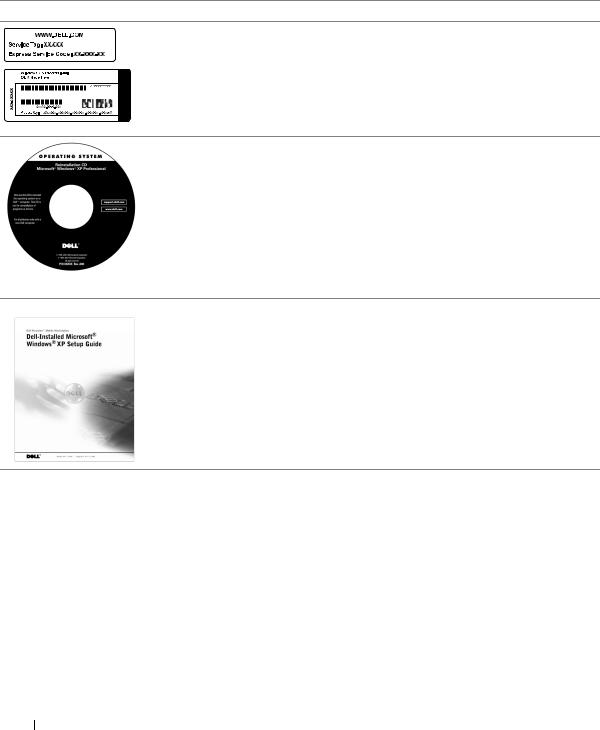
w w w . d e l l . c o m | s u p p o r t . d e l l . c o m
Resource
Contents |
Using the Resource |
Service and Registration |
The Express Service Code and Service Tag Sequence are |
Labels |
unique identifiers for your Dell computer. |
• Express Service Code and |
You will need the Product Key (or Product ID) number to |
Service Tag Sequence |
complete the operating system setup. |
•Product Key (also called the Product ID or Certificate of Authenticity [COA])
Operating System CD |
To reinstall your operating system, use the Operating |
|
System CD that came with your computer. |
|
NOTE: The Operating System CD may not include all the |
|
latest drivers for your computer. If you reinstall your |
|
operating system, use the Drivers and Utilities CD to |
|
reinstall drivers for the devices shipped with your |
|
computer. |
|
For more information about installing your operating |
|
system, see the Dell-installed Microsoft® Windows® |
|
Setup Guide that came with your computer. |
Dell-installed Windows Setup See the Setup Guide for information on installing and Guide configuring your operating system.
NOTE: To obtain information on your operating system, click the Start button and click Help or Help and Support, depending on your operating system.
16 System Information Guide

Resource |
Contents |
Using the Resource |
Dell | Support website
•Frequently asked questions
•Downloads for your computer
•Documentation
•Online discussions about your computer
•Searchable database
Go to support.dell.com and complete the one-time registration:
•View the User’s Guide for your computer
•Get help with general usage, installation, and troubleshooting questions (Ask Dudley, Dell Knowledge Base)
•Access documentation about your computer and devices (Dell Documents)
•Get the latest versions of the drivers for your computer (Downloads for Your Dell)
•Join online discussions with other Dell customers and Dell technical professionals (Dell Talk)
|
• Explore a list of online links to Dell's primary vendors |
|
|
Dell Premier Support website |
Go to premiersupport.dell.com: |
• Service call status |
The Dell Premier Support website is customized for |
• Top technical issues by |
corporate, government, and education customers. |
product |
This service may not be available in all regions. |
|
•Frequently asked questions by product number
•Customized service tags
•System configuration detail
System Information Guide |
17 |
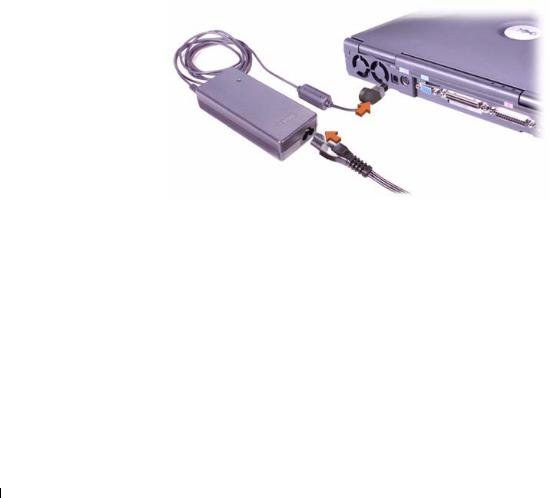
w w w . d e l l . c o m | s u p p o r t . d e l l . c o m
Setting Up Your Computer
1Unpack the accessories box.
2Set aside the contents of the accessories box, which you will need to complete the setup of your computer.
The accessories box also contains user documentation and any software or additional hardware (such as PC Cards, drives, or batteries) you have ordered.
3Connect the AC adapter to the AC adapter connector and to the electrical outlet.
C o n n e c t i n g t h e A C A d a p t e r
18 System Information Guide
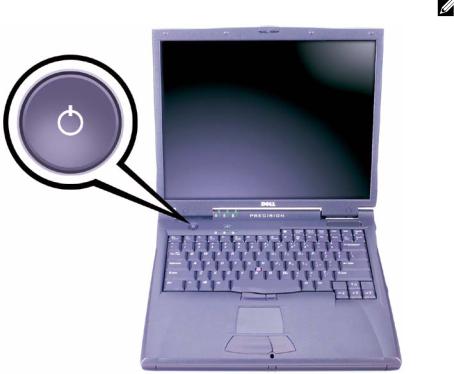
4Open the computer display and press the power button to turn on the computer.
Po w e r B u t t o n
NOTE: Do not dock the computer until it has been turned on and shut down at least once.
About Your Computer
Front View
 CAUTION: Do not block, push objects into, or allow dust to accumulate in the air vents. Doing so can damage the computer or cause a fire.
CAUTION: Do not block, push objects into, or allow dust to accumulate in the air vents. Doing so can damage the computer or cause a fire.
System Information Guide |
19 |
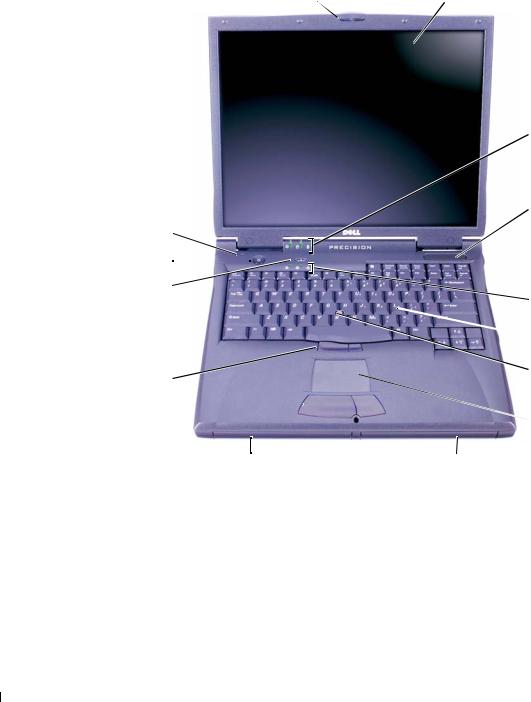
w w w . d e l l . c o m | s u p p o r t . d e l l . c o m
1 |
2 |
 3
3
 4
4
14
13
12
 5
5
 6
6
 7
7
11
 8
8
|
10 |
|
9 |
|
|
|
|
1 |
display latch |
8 |
touch pad |
|
|
|
|
2 |
display |
9 |
battery bay |
|
|
|
|
3 |
device status lights |
10 |
module bay |
|
|
|
|
4 |
air vent |
11 |
track stick/touch pad buttons |
|
|
|
|
5 |
keyboard status lights |
12 |
Dell AccessDirect™ button |
|
|
|
|
6 |
keyboard |
13 |
power button |
|
|
|
|
7 |
track stick |
14 |
microphone |
20 System Information Guide
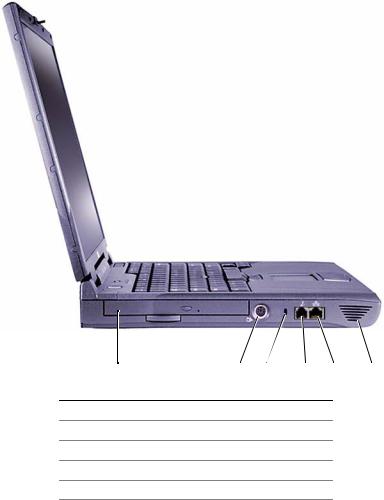
Left Side View
1 |
2 |
3 |
4 |
5 |
6 |
1fixed optical drive
2S-video TV-out connector
3security cable slot
4modem connector
5network connector
6speaker
System Information Guide |
21 |

w w w . d e l l . c o m | s u p p o r t . d e l l . c o m
Right Side View
 CAUTION: Do not block, push objects into, or allow dust to accumulate in the air vents. Doing so can damage the computer or cause a fire.
CAUTION: Do not block, push objects into, or allow dust to accumulate in the air vents. Doing so can damage the computer or cause a fire.
|
|
|
|
|
|
|
|
|
|
|
|
|
|
|
|
|
|
|
|
|
|
|
|
|
|
|
|
|
|
|
|
|
|
|
|
|
|
|
|
|
|
|
|
|
|
|
|
|
|
|
|
|
|
|
|
|
|
|
|
1 |
|
2 |
3 |
4 |
5 |
6 |
7 |
8 |
|||
|
|
|
|
|
|
|
|
|
|
|
|
1 |
speaker |
|
|
|
|
|
|
5 |
PC Card slot |
||
|
|
|
|
|
|
|
|
|
|
||
2 |
security cable slot |
|
|
|
|
6 |
IEEE 1394 connector |
||||
|
|
|
|
|
|
|
|
|
|
|
|
3 |
hard drive bay |
|
|
|
|
|
7 |
audio connectors |
|||
|
|
|
|
|
|
|
|
|
|
||
4 |
infrared sensor |
|
|
|
|
8 |
air vents |
||||
22 System Information Guide

Back View
NOTICE: To avoid damaging the computer, wait 5 seconds after turning off the computer before you disconnect an external device.
 CAUTION: Do not block, push objects into, or allow dust to accumulate in the air vents. Doing so can damage the computer or cause a fire.
CAUTION: Do not block, push objects into, or allow dust to accumulate in the air vents. Doing so can damage the computer or cause a fire.
1 |
2 |
3 |
4 |
5 |
6 |
7 |
8 |
1 |
fans (2) |
5 |
docking connector |
|
|
|
|
2 |
AC adapter connector |
6 |
parallel connector |
|
|
|
|
3 |
PS/2 connector |
7 |
serial connector |
|
|
|
|
4 |
video connector |
8 |
USB connectors (2) |
System Information Guide |
23 |

w w w . d e l l . c o m | s u p p o r t . d e l l . c o m
Bottom View
1 |
2 |
 3
3
4
1memory module and modem cover
2device release latches
3Mini PCI card cover
4docking device latch
24 System Information Guide
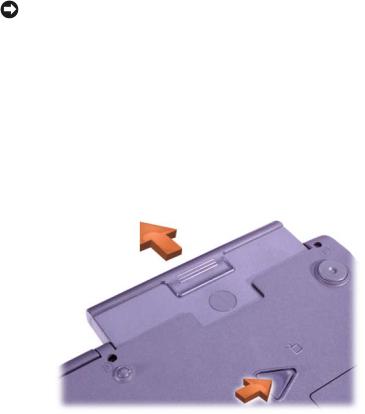
Removing a Battery
NOTICE: If you choose to replace the battery with the computer in standby mode, you have only about 1 minute to complete the battery replacement before the computer shuts down and loses any unsaved data.
Before removing the battery, ensure that the computer is turned off, suspended in a power management mode, or connected to an electrical outlet.
1If the computer is docked, undock it.
2Slide and hold the battery bay (or module bay) latch release on the bottom of the computer, and then slide the battery from the bay.
Installing a Battery
Slide the battery into the bay until the latch release clicks.
Running the Dell Diagnostics
Dell provides a number of tools to help you if your computer does not perform as expected. For information on these help tools, see your
User’s Guide.
System Information Guide |
25 |

w w w . d e l l . c o m | s u p p o r t . d e l l . c o m
NOTE: Run the Diagnostics before you call Dell technical support because the diagnostic tests provide information you may need when
you call.
NOTE: Write down your current boot sequence in the event you want to restore it after running the Dell Diagnostics.
If you have a computer problem and are unable to access the online User’s Guide, use the Dell Diagnostics to help you determine the cause of the problem and to help you solve it. The Diagnostics are on the Drivers and Utilities CD that came with your computer.
To start the Diagnostics, perform the following steps:
1Turn off the computer.
2If the computer is docked, undock the computer.
3Ensure that the computer is connected to an electrical outlet.
4Turn on the computer with the Driver and Utilities CD in the CD, CD-RW, or DVD drive.
5Press  to enter the system setup program as soon as the Dell logo screen appears, and before the Microsoft Windows logo screen appears.
to enter the system setup program as soon as the Dell logo screen appears, and before the Microsoft Windows logo screen appears.
6Select the Boot Order page of the system setup program. Make a note of the device currently set as the first (top) boot device, and then set the first three devices in the boot sequence in the following order:
•Diskette Drive
•CD/DVD/CD-RW Drive
•Internal HDD
7Save your changes and press  to exit the system setup program and restart the computer to boot from the CD.
to exit the system setup program and restart the computer to boot from the CD.
The computer starts and automatically begins to run the Dell Diagnostics.
8When you have completed running diagnostics, remove the Drivers and Utilities CD.
9When the computer restarts, press  as soon as the Dell logo screen appears, and before the Microsoft Windows logo screen appears.
as soon as the Dell logo screen appears, and before the Microsoft Windows logo screen appears.
10In the system setup program, select the Boot Order page and reset the boot sequence to the original order.
11Press  to exit the system setup program and restart Microsoft Windows.
to exit the system setup program and restart Microsoft Windows.
12Remove the CD from the CD, CD-RW, or DVD drive.
26 System Information Guide
When you start the diagnostics, the Dell logo screen appears, followed by a message telling you that the diagnostics is loading. After the diagnostics loads, the Diagnostics Menu appears.
To select an option from this menu, highlight the option and press
 , or press the key that corresponds to the highlighted letter in the option you choose.
, or press the key that corresponds to the highlighted letter in the option you choose.
Regulatory Notices
Electromagnetic Interference (EMI) is any signal or emission, radiated in free space or conducted along power or signal leads, that endangers the functioning of a radio navigation or other safety service or seriously degrades, obstructs, or repeatedly interrupts a licensed radio communications service. Radio communications services include but are not limited to AM/FM commercial broadcast, television, cellular services, radar, air-traffic control, pager, and Personal Communication Services (PCS). These licensed services, along with unintentional radiators such as digital devices, including computers, contribute to the electromagnetic environment.
Electromagnetic Compatibility (EMC) is the ability of items of electronic equipment to function properly together in the electronic environment. While this computer has been designed and determined to be compliant with regulatory agency limits for EMI, there is no guarantee that interference will not occur in a particular installation. If this equipment does cause interference with radio communications services, which can be determined by turning the equipment off and on, you are encouraged to try to correct the interference by one or more of the following measures:
•Reorient the receiving antenna.
•Relocate the computer with respect to the receiver.
•Move the computer away from the receiver.
•Plug the computer into a different outlet so that the computer and the receiver are on different branch circuits.
If necessary, consult a Dell Technical Support representative or an experienced radio/television technician for additional suggestions.
System Information Guide |
27 |

w w w . d e l l . c o m | s u p p o r t . d e l l . c o m
Dell computers are designed, tested, and classified for their intended electromagnetic environment. These electromagnetic environment classifications generally refer to the following harmonized definitions:
•Class A is typically for business or industrial environments.
•Class B is typically for residential environments.
Information Technology Equipment (ITE), including devices, expansion cards, printers, input/output (I/O) devices, monitors, and so on, that are integrated into or connected to the computer should match the electromagnetic environment classification of the computer.
A Notice About Shielded Signal Cables: Use only shielded cables for connecting devices to any Dell device to reduce the possibility of interference with radio communications services. Using shielded cables ensures that you maintain the appropriate EMC classification for the intended environment. For parallel printers, a cable is available from Dell. If you prefer, you can order a cable from Dell on the World Wide Web at accessories.us.dell.com/.
Most Dell computers are classified for Class B environments. However, the inclusion of certain options can change the rating of some configurations to Class A. To determine the electromagnetic classification for your computer or device, see your User’s Guide specific information from each regulatory agency. Each section provides country-specific EMC/EMI or product safety information.
Battery Disposal
Your computer uses an lithium-ion battery and a nickel-metal hydride (NiMH) reserve battery. For instructions about replacing the lithium-ion battery in your computer, see “Using the Battery” in your Dell User’s Guide. The NiMH battery is a long-life battery, and it is very possible that you will never need to replace it. However, should you need to replace it, the procedure must be performed by an authorized service technician.
Do not dispose of the battery along with household waste. Contact your local waste disposal agency for the address of the nearest battery deposit site.
28 System Information Guide
